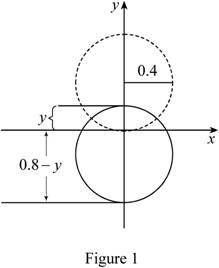
Concept explainers
(a)
To show that: The percentage of the volume of the object above the surface of the liquid is
(a)
Explanation of Solution
Given information:
The buoyant force is
The weight of the object is
Calculation:
Consider the volume above the surface as follows:
Modify Equation (1).
Divide both sides of the Equation by
Apply Archimedes Principle as shown below.
Substitute
Substitute
Find the percentage of the volume above the surface.
Therefore, the percentage of the volume of the object above the surface of the liquid is
(b)
To calculate: The percentage of the volume of an iceberg above the water.
(b)
Answer to Problem 4P
The percentage of the volume of an iceberg above the water is
Explanation of Solution
Given information:
The density of ice is
The density of seawater is
Calculation:
Refer to part (a).
The percentage of the volume of the object above the surface of the liquid is
Substitute
Therefore, the percentage of the volume of an iceberg above the water is
(c)
To show: Does the water overflow when the ice melts?
(c)
Answer to Problem 4P
The water does not overflow when the ice melts.
Explanation of Solution
Given information:
An ice cube floats in a glass filled to the brim with water.
Calculation:
Let
Refer to part (a).
The volume of ice above the surface of the water is
The volume below the surface of the water is,
Suppose the mass of the ice cube is the same as the mass of the water which is formed when the cube melts.
So, when the ice cube melts the volume of the resulting water is same as the underwater volume of the ice cube.
Hence, the water does not overflow when the ice melts.
(d)
To calculate: The work required to completely submerge the sphere.
(d)
Answer to Problem 4P
The work required to completely submerge the sphere is
Explanation of Solution
Given information:
A sphere of radius 0.4 m.
Density of the water is
Calculation:
Suppose the height of the exposed part of the ball is y.
Sketch the instant when the height of the exposed part of the ball is y as shown in Figure 1.

Refer to Figure 1.
Find the volume of the segment of a sphere as shown below.
Substitute 0.4 m for r and
Modify the above Equation as shown below.
Find the work done to submerge the sphere.
Therefore, the work required to completely submerge the sphere is
Chapter 6 Solutions
Single Variable Calculus: Concepts and Contexts, Enhanced Edition
- Use the properties of logarithms, given that In(2) = 0.6931 and In(3) = 1.0986, to approximate the logarithm. Use a calculator to confirm your approximations. (Round your answers to four decimal places.) (a) In(0.75) (b) In(24) (c) In(18) 1 (d) In ≈ 2 72arrow_forwardFind the indefinite integral. (Remember the constant of integration.) √tan(8x) tan(8x) sec²(8x) dxarrow_forwardFind the indefinite integral by making a change of variables. (Remember the constant of integration.) √(x+4) 4)√6-x dxarrow_forward
- a -> f(x) = f(x) = [x] show that whether f is continuous function or not(by using theorem) Muslim_mathsarrow_forwardUse Green's Theorem to evaluate F. dr, where F = (√+4y, 2x + √√) and C consists of the arc of the curve y = 4x - x² from (0,0) to (4,0) and the line segment from (4,0) to (0,0).arrow_forwardEvaluate F. dr where F(x, y, z) = (2yz cos(xyz), 2xzcos(xyz), 2xy cos(xyz)) and C is the line π 1 1 segment starting at the point (8, ' and ending at the point (3, 2 3'6arrow_forward
- I need help in ensuring that I explain it propleryy in the simplifest way as possiblearrow_forwardI need help making sure that I explain this part accutartly.arrow_forwardPlease help me with this question as I want to know how can I perform the partial fraction decompostion on this alebgric equation to find the time-domain of y(t)arrow_forward
 Calculus: Early TranscendentalsCalculusISBN:9781285741550Author:James StewartPublisher:Cengage Learning
Calculus: Early TranscendentalsCalculusISBN:9781285741550Author:James StewartPublisher:Cengage Learning Thomas' Calculus (14th Edition)CalculusISBN:9780134438986Author:Joel R. Hass, Christopher E. Heil, Maurice D. WeirPublisher:PEARSON
Thomas' Calculus (14th Edition)CalculusISBN:9780134438986Author:Joel R. Hass, Christopher E. Heil, Maurice D. WeirPublisher:PEARSON Calculus: Early Transcendentals (3rd Edition)CalculusISBN:9780134763644Author:William L. Briggs, Lyle Cochran, Bernard Gillett, Eric SchulzPublisher:PEARSON
Calculus: Early Transcendentals (3rd Edition)CalculusISBN:9780134763644Author:William L. Briggs, Lyle Cochran, Bernard Gillett, Eric SchulzPublisher:PEARSON Calculus: Early TranscendentalsCalculusISBN:9781319050740Author:Jon Rogawski, Colin Adams, Robert FranzosaPublisher:W. H. Freeman
Calculus: Early TranscendentalsCalculusISBN:9781319050740Author:Jon Rogawski, Colin Adams, Robert FranzosaPublisher:W. H. Freeman
 Calculus: Early Transcendental FunctionsCalculusISBN:9781337552516Author:Ron Larson, Bruce H. EdwardsPublisher:Cengage Learning
Calculus: Early Transcendental FunctionsCalculusISBN:9781337552516Author:Ron Larson, Bruce H. EdwardsPublisher:Cengage Learning





